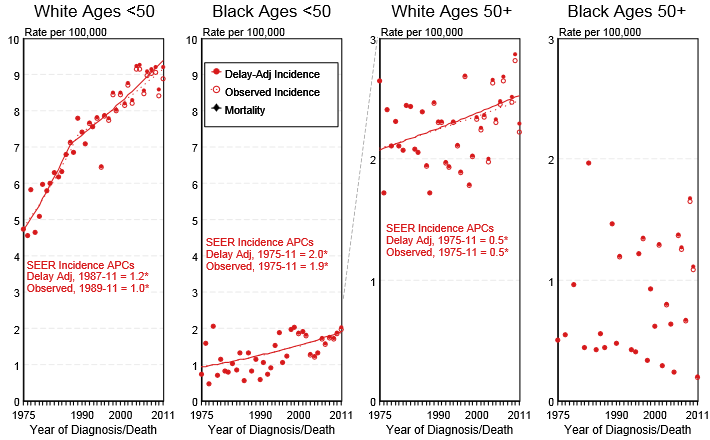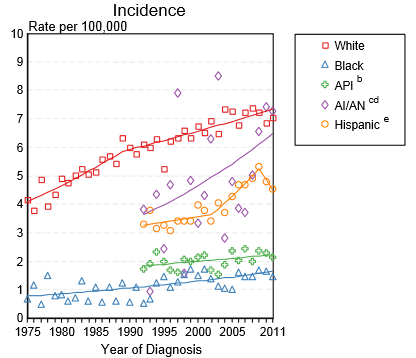Testicular cancer epidemiology and demographics
Editor-In-Chief: C. Michael Gibson, M.S., M.D. [1]; Associate Editor(s)-in-Chief: Rim Halaby, M.D. [2]
|
Testicular cancer Microchapters |
|
Diagnosis |
|---|
|
Treatment |
|
Case Studies |
|
Testicular cancer epidemiology and demographics On the Web |
|
American Roentgen Ray Society Images of Testicular cancer epidemiology and demographics |
|
Risk calculators and risk factors for Testicular cancer epidemiology and demographics |
Overview
Testicular cancer is most common among Caucasians and rare among African Americans. In the United States, the age-adjusted prevalence of testicular cancer is 88.1 per 100,000 in 2011.[1] Although testicular cancer is most common among men aged 15-40 years, it has three peaks: infancy, ages 25-40 years, and age 60 years.
Epidemiology and Demographics
Prevalence
- Testicular cancer is most common among Caucasians and rare among African Americans. Testicular cancer is uncommon in Asia and Africa. Worldwide incidence has doubled since the 1960s, with the highest rates of prevalence in Scandinavia, Germany, and New Zealand.
- In the United States, the age-adjusted prevalence of testicular cancer is 88.1 per 100,000 in 2011.[1]
Incidence
- Incidence among African Americans doubled from 1988 to 2001 with a bias towards seminoma. The lack of significant increase in the incidence of early-stage testicular cancer during this timeframe suggests that the overall increase was not due to heightened awareness of the disease.
- The delay-adjusted incidence of testicular cancer in 2011 was estimated to be 5.98 per 100,000 persons in the United States.[1]
- In 2011, the age-adjusted incidence of testicular cancer was 5.88 per 100,000 persons in the United States.[1]
Age
- Although testicular cancer is most common among men aged 15-40 years, it has three peaks: infancy, ages 25-40 years, and age 60 years.
- Germ cell tumors of the testis are the most common cancer in young men between the ages of 15 and 35 years.
- While the overall age-adjusted incidence of testicular cancer in the United States between 2007 and 2011 is 5.6 per 100,000, the age-adjusted incidence of testicular cancer by age category is:[1]
- Under 65 years: 6.2 per 100,000
- 65 and over: 1.2 per 100,000
- Shown below is an image depicting the incidence of testicular cancer by age and race in the United States between 1975 and 2011.[1]
Race
- Shown below is a table depicting the age-adjusted prevalence of testicular cancer by race in 2011 in the United States.[1]
| All Races | White | Black | Asian/Pacific Islander | Hispanic | |
| Age-adjusted prevalence | 88.1 per 100,000 | 108.4 per 100,000 | 19.3 per 100,000 | 28.2 per 100,000 | 64.2 per 100,000 |
- Shown below is an image depicting the incidence of testicular cancer by race in the United States between 1975 and 2011.[1]
API: Asian/Pacific Islander; AI/AN: American Indian/ Alaska Native
References
- ↑ 1.0 1.1 1.2 1.3 1.4 1.5 1.6 1.7 Howlader N, Noone AM, Krapcho M, Garshell J, Miller D, Altekruse SF, Kosary CL, Yu M, Ruhl J, Tatalovich Z,Mariotto A, Lewis DR, Chen HS, Feuer EJ, Cronin KA (eds). SEER Cancer Statistics Review, 1975-2011, National Cancer Institute. Bethesda, MD, http://seer.cancer.gov/csr/1975_2011/, based on November 2013 SEER data submission, posted to the SEER web site, April 2014.

